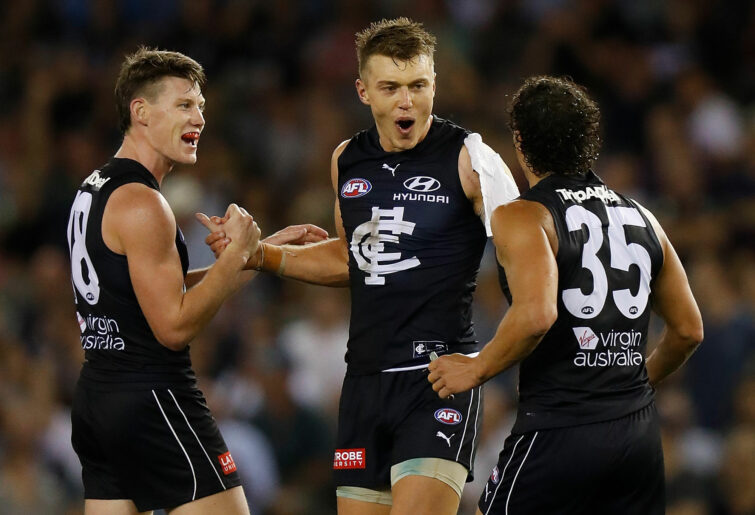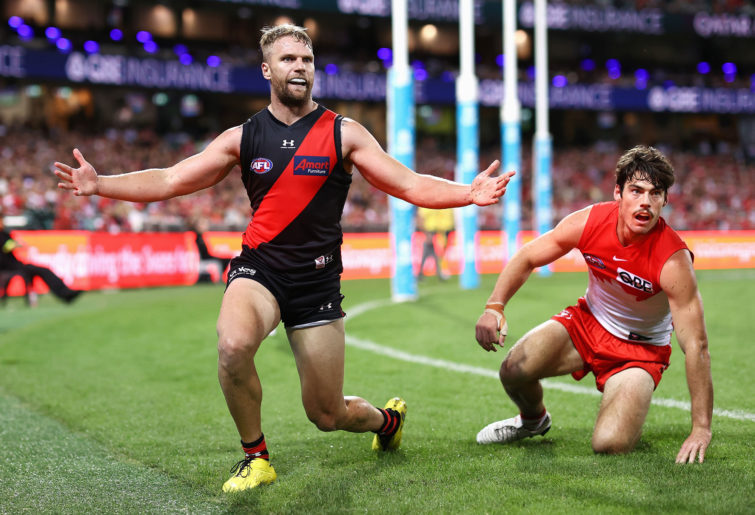How much money does the AFL make from TV rights?
In 2019, the AFL’s revenue was $793.8 million, and over half of that money came from their broadcast partners Telstra, Foxtel, and Channel Seven, who pay $418 million a season.
The AFL adjusts their fixtures, changes rules, and markets their game with the maximisation of TV audiences in the forefront of their minds with every decision. This is because of their dependence on broadcast money to survive.
With TV audiences rising 15 per cent last year, the AFL’s next broadcasting rights deal will be once again contested by the big Australian media companies, but this time new players will join the negotiations.
Big tech investment
Investment into the AFL by Amazon, Google, and Facebook all loom large for the AFL and Australian media companies alike. In 2019, AFL CEO Gillon McLachlan travelled to the United States to meet with these three companies to discuss investment into the live streaming of AFL matches.
Amazon seems the most likely to invest, as they’ve shown their willingness to be involved with the sport since their $10 million spend on the Making Their Mark AFL documentary series last year.
According to the Forex Market Sentiment, Amazon is the fourth largest company in the world, and with their video streaming service Amazon Prime in fierce competition with Netflix, Stan, Disney Plus and Binge for Australian subscribers, they’re attempting to use the AFL to gain market share in Australia.

(Photo by Michael Willson/AFL Photos via Getty Images)
Founder of News Corporation Rupert Murdoch also used this strategy to sell subscriptions to Foxtel, a subscription pay TV service. He once said in a 1996 interview that he would “use sports as a battering ram and a lead offering in all our pay television operations.”
Amazon has already begun their investment into sports. Last month they announced a new deal with the largest sporting league in the world, the NFL.
The NFL’s TV broadcasting rights deal was finalised last month, with the league reaching an 11-year US$89.5 billion (A$115 billion) agreement with Fox, CBS, ESPN, and NBC. The deal is worth over US$100 billion (A$129 billion) when you include the US$1 billion (A$1.3 billion) a season Amazon is paying to exclusively broadcast Thursday night football through their Amazon Prime service.
The broadcasting rights deal breaks the league’s games into five categories: Monday night football, Thursday night football, Sunday night football, American Football Conference Sunday afternoon matches, and National Football Conference Sunday afternoon matches.
The NFL sold the five categories of games individually to the five media companies in the deal, which enabled them to increase the total revenue they gained from this deal.
This deal is a 108 per cent increase compared with the US$43.1 billion (A$55.6 billion) deal the NFL secured with their last rights deal.
So why is this relevant to the AFL? The AFL will look at the model the NFL employed and adopt a version of it in their upcoming rights deal to increase the total revenue they garner from it.
In the current deal, Channel Seven can broadcast four games of their choosing throughout the round, Foxtel can broadcast all nine games, and Telstra can offer mobile phone live streaming through the AFL app for every game.
The AFL is slowly weaning the public onto Thursday games, from a single Thursday night match back in 2013 to eight within the first 15 rounds of the 2021 season.

(Photo by Cameron Spencer/Getty Images)
Thursday night games have rated extremely well this season, with 780,000 to 1.3 million people watching the individual Thursday night fixtures this season.
As the NFL has done, the AFL could sell Thursdays as a permanent standalone time slot in the upcoming rights deal. Previous broadcast partners of the AFL Network Ten and Channel Nine don’t have the budget to compete with Channel Seven to broadcast four free-to-air games during the week but could invest heavily into Thursday night footy and make that time slot their own.
COVID-19’s impact on TV rights deals
Sports broadcasts are a staple of the Australian way of life. Almost every Aussie will tune into a game at least once a season. Although televised sport is being broadcast on every phone, laptop, or television in this country, not many of us will take any interest in how that sport got to our screen. Not many of us think twice about the politics and money behind the scenes that enables us to watch the sport we want to when we want to.
The AFL, NRL and cricket all had moments in 2020 where it looked as though their season wouldn’t be completed, which prompted writers and commentators alike to report on the doomsday scenarios if this turned into a reality. Although makeshift seasons were pushed through by all three sports, the financial burden the three codes suffered couldn’t be overstated.
During the 2020 season, the AFL cut all the proverbial fat from their books, slashing player salaries in half, taking $3 million off every club’s coaching salary cap, and furloughing or cutting 80 per cent of jobs at AFL headquarters and clubs. The AFL suffered a $22.8 million loss in the 2020 season, a far cry from the $48.5 million profit in 2019, and without these cost-cutting measures, the $71.3 million discrepancy would be unfathomably larger.
The AFL also shortened their 2020 season from 22 games per club to 17 games, leaving media companies with less content than they had in previous seasons. The NRL had the same problem as they shortened their season from 24 games to 20 games.
The broadcast partners from these sports felt they had been short-changed in their rights deals because of this, so all parties involved went back to the negotiation table for revised deals.
The AFL extended Channel Seven’s contract by two seasons, with the deal now ending in the 2024 season. The revised deal granted Channel Seven a 19 per cent pay cut per season.

(Photo by Dylan Burns/AFL Photos via Getty Images)
The new five-year deal (2020-2024) is worth $730 million over that period, giving Channel Seven a net saving of $87 million.
Foxtel also received a two-season extension on their deal, saving $30 million over the two-year extension.
The NRL also negotiated a deal with their host broadcasters Channel Nine and Foxtel. The new deal granted Channel Nine an $80 million saving until the end of their current deal, which concludes at the end of the 2022 season.
The NRL and Foxtel revised their current deal, but the official figures of the agreement were not released to the public.
Media expert and social commentator Thomas Moore enjoyed the deal, as it was truly a win-win for both parties.
“Thank God for Seven and Foxtel, I remember Eddie McGuire saying the future of the AFL was in jeopardy at the start of the pandemic,” Moore says.
“The AFL’s reliance on TV money was really brought to the fore when the season came tumbling down. People don’t really look favourably on big, rich companies like Foxtel and Seven, but they really did save footy with the deals they struck with the AFL.
“I suppose they’re longstanding partnerships that have been beneficial to all parties for many years now, so it was a bit of a ‘you scratch my back, I’ll scratch your back’ scenario.”
Cricket Australia and Channel Seven’s stoush
Unlike the NRL and the AFL, Cricket Australia’s season was largely unaffected by the pandemic.
Cricket Australia (CA) reached a six-year, $450 million agreement with Channel Seven in 2018. This deal allowed Channel Seven to broadcast men’s Tests, women’s internationals, BBL and WBBL. Foxtel was granted access to every Australian cricket match over the same period in a deal worth $600 million.
The original fixturing of the 2020 summer of cricket opened with a four-Test series against India, before finishing with the ODIs and T20s. However, as COVID-19 cancelled the majority of the 2020 season, the touring Indian team hadn’t been competing in Test matches for months before arriving in Australia. Because of this, the Board of Control for Cricket (BCCI) in India requested the ODIs and T20s be played prior to the Test series to properly condition their players.
CA agreed to the BCCI’s request and rescheduled their summer of cricket to accommodate the touring Indians.
Channel Seven was not consulted about these changes and requested CA reverse their decision, as they wanted their content to open the summer of cricket to maximise ratings for their product.
CA refused this request, which led to an ongoing battle between the two parties, with the matter currently being contested in a court battle.































































































